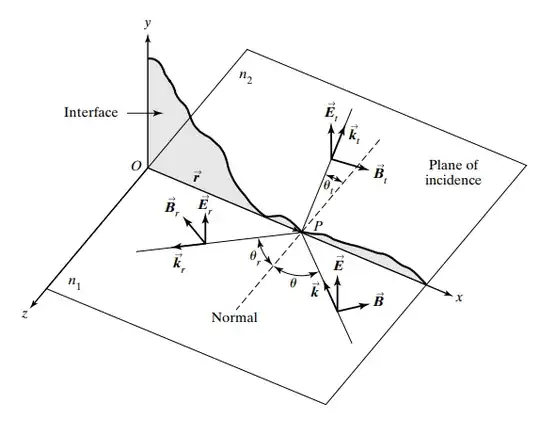I am self-studying Optics by Pedrotti. In Chapter 24 of the 3rd edition, Pedrotti derives the Fresnel Equations accompanied by the figure below. I don't understand Pedrotti's proof that the incident, reflected, and transmitted waves are coplanar. I have seen this answer which provides a more involved justification of why they must be coplanar, but I am curious about Pedrotti's simple justification.
I'll state my question here and then provide background below.
How is it that the conditions
$$ (\vec{k} - \vec{k}_r) \cdot \vec{r} = (\vec{k} - \vec{k}_t) \cdot \vec{r} = (\vec{k}_r - \vec{k}_t) \cdot \vec{r} = 0 $$
imply that $\vec{k},\vec{k}_t,\vec{k}_r$ are coplanar?
For example, $(\vec{k}-\vec{k}_t)\cdot\vec{r} = 0$ implies that $\vec{k}-\vec{k}_t$ is perpendicular to $\vec{r}$, but not necessarily that it lies in the plane of $\vec{k}$ and $\vec{r}$. Why couldn't $\vec{k}_t$ have a component that is out of the plane of incidence?
Pedrotti writes:
In the boundary plane $xy$, where all three waves exit simultaneously, there must be a fixed relationship between the three wave amplitudes (and thus their irradiances) that has yet to be determined. Since such a relationship cannot depend on the arbitrary choice of a boundary point $\vec{r}$ nor a time $t$, it follows that the phases of the three waves, which depend on $\vec{r}$ and $t$, must themselves be equal: $$ (\vec{k} \cdot \vec{r} - \omega t) = (\vec{k}_r \cdot \vec{r} - \omega_r t) = (\vec{k}_t \cdot \vec{r} - \omega_t t) $$ In particular, at the boundary point $\vec{r} = 0$ of Figure 1, $$ -\omega t = -\omega_r t = -\omega_t t $$ or $$ \omega = \omega_r = \omega_t $$ so that all frequencies are equal. On the other hand, when $t=0$, $$ \vec{k} \cdot \vec{r} = \vec{k}_r \cdot \vec{r} = \vec{k}_t \cdot \vec{r} $$ Several conclusions can be drawn from this equation. First notice that by subtracting any two members, these relations are equivalent to: $$ (\vec{k} - \vec{k}_r) \cdot \vec{r} = (\vec{k} - \vec{k}_t) \cdot \vec{r} = (\vec{k}_r - \vec{k}_t) \cdot \vec{r} = 0 $$ which requires that the vectors $\vec{k}$, $\vec{k}_r$, and $\vec{k}_t$ lie in the plane determined by the vectors $\vec{k}$ and $\vec{r}$. Thus all three propagation vectors are coplanar in the $xz$-plane, and we conclude that the reflected and refracted waves lie in the plane of incidence.
